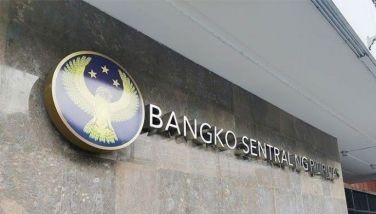Win-win for the peso
Last month, Philequity was invited to speak in a forum organized by the Management Association of the Philippines (MAP) titled “An appropriate foreign exchange regime for the Philippines: Where is the Peso Heading?†The forum’s objective was to present varying views on foreign exchange policy as a strategy for economic development, and the benefits and pitfalls of portfolio hot money. Philequity was given the task of forecasting the peso using technical analysis. We presented two scenarios: (1) the peso breaks below 40, and (2) the peso holds ground and climbs towards the 41 level.
40 is the crucial number
But before we go there, let us look at the two-decade chart shown below. Observe that the USD-PHP rate peaked at 56.50 in 2005 and has been on a downtrend since. In technical analysis, 40 is the crucial support level for the peso because it was the low established back in 2008. The next support level is at 37.50, a level that the peso traded as far back as 1999.
The rule of round numbers
In technical analysis again, there is a so-called rule of round numbers, such that when round numbers are breached, like 10,000 for the Dow Jones, 5,000 for the PSEi, or in this case, 40 for the peso, they become major psychological support or resistance areas. After 40, the next support is at 37.50 to 38.00 which we think is a weak support and can easily be broken.
Scenario 1: The peso breaks below 40
The first scenario is when the peso breaks below 40. It should then find temporary support at 37.50. The peso may then bounce back towards 40 which by then would already be a formidable resistance (the rule of round numbers). From a technical standpoint, if the peso breaks below 40, the next objective really is 35.50 and ultimately 30.

Note: The bold lines are possible technical price movements.
Scenario 2: Peso holds above 40 and climbs towards the 41 level
The second scenario is for the peso to hold above 40 and start climbing back towards the 41 level. This, we said, is our preferred scenario. A break above 41 should find the peso testing 41.50 and then possibly 42. Note that the peso faces a lot of resistance levels going up and the climb back may be difficult. But in doing so, it would now mean that the momentum has shifted from having a downward bias to one that is neutral.
The peso trading between 41 and 42 would now provide greater stability. This “basing pattern†should hold for a few years and create less volatility for the Philippine peso.

Note: The bold lines are possible technical price movements.
Too strong a peso is bad
Ever since we called the top in the USD-PHP rate back in 1995 (see Philippine Peso… The Strongest Currency in Asia, Oct. 24, 1995), we have repeatedly forecasted an appreciating peso up until August 2010 when we said that “we expect the peso to reach 44 by end-2010, 42 by end-2011 and 40 by end-2012†(see Peso targets 40, August 23, 2010). We also said that the appreciating peso is good for the country because it reflects the country’s good fundamentals.
Last year, however, we changed our tone. In one article, we said that while the Philippine peso and the stock market have shown strong positive correlation, a stronger peso from hereon may have mixed results (see Be careful what you wish for, May 7, 2012).
In another article, we cautioned against the strong appreciation of the peso vis-a-vis the Indian rupee which may impact our BPO sector (see Strong peso – too much of a good thing, July 9, 2012).
We also advised in these articles that the Philippines should learn from Japan whose export sector has become uncompetitive due to the strong yen since the Plaza Accord back in 1985. As a result, the Japanese stock market entered a 23-year bear market and their economy stagnated in what is known as the “Lost Decades of Japan.â€
Shock and awe from Bank of Japan (BOJ)
Japan is now taking extreme measures to get out of its deflation thru Abenomics and BOJ Kuroda’s quantitative easing (QE) initiatives. Just last week, Kuroda announced plans to double BOJ’s monthly bond purchases to about 7.5 trillion yen ($77.8 billion). Japan’s all-out approach aims to get their economy out of deflation with a target of 2 percent inflation by doubling the monetary base, purchasing bonds, ETFs and REITS.
The consequence of Kuroda’s extraordinary inflationary tools is a weaker yen. Note that the Japanese yen has already fallen 19.7 percent against the US dollar the past six months and 19.9 percent against the Philippine peso over the same period.
Strong dollar giving the peso a respite
What is helping the peso hold above 40 is the strong US dollar and BSP’s measures to stop speculative attacks on the peso. And if the US economy continues to improve, we expect the dollar index to rally further. This will not only give the peso respite but also bring back the peso to 42.
Last Friday the peso closed above 41 against the US dollar despite the Philippines getting a credit rating upgrade. This is a good signal that the peso may finally be stabilizing.
The Goldilocks scenario: 41 to 42
Many foreign banks and major houses forecasted that the peso will end the year at 37 to 38. We believe they will be wrong. We in Philequity, think that there is a greater likelihood that the peso will stabilize between 41 and 42. For us this is the sweet spot or the “goldilocks scenario†for the peso (i.e. not too strong and not too weak). We believe that the peso going above 41 is great news for the Philippine economy and a WIN-WIN FOR EVERYBODY.
We believe that anything below 40 is counterproductive and will be entering a precarious level for the economy as a whole. We believe that the peso stabilizing between 41 and 42 would be beneficial and WIN-WIN FOR ALL (businesses, exporters, importers, consumers, BPOs and OFWs).
Kudos to the BSP
Congratulations to the BSP for successfully stabilizing the peso. With QEs left and right (coming from Japan, US, UK and the EU), the BSP cannot stand idly. If not for the BSP’s timely dollar purchases and other measures such as lowering the SDA rates, caps on NDFs, and liberalizing foreign exchange purchases, we believe that the peso would have already breached 40 – which would have been very dangerous. While the BSP maintains a market driven policy on the exchange rate, its mandate is to provide stability in case of excessive inflows of speculative foreign “hot money.†The BSP has done its task remarkably.
Condolences to the family of Vicente “Ting†Jayme
We express our deepest condolences to the family of former Finance Secretary Vicente “Ting†Jayme. Mr. Jayme, who was also a former director of Philequity Fund, passed away last April 3.
For further stock market research and to view our previous articles, please visit our online trading platform at www.wealthsec.com or call 634-5038. Our archived articles can also be viewed at www.philequity.net.
- Latest
- Trending
































